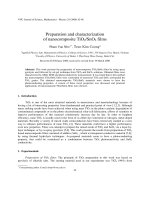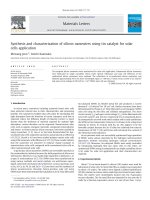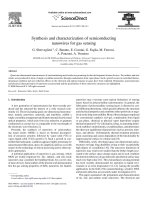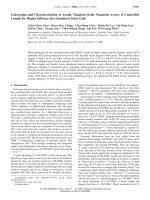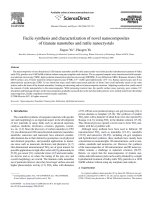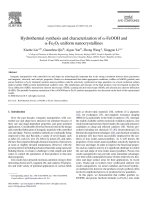- Trang chủ >>
- Khoa Học Tự Nhiên >>
- Vật lý
preparation and characterization of cnts tio2 composites
Bạn đang xem bản rút gọn của tài liệu. Xem và tải ngay bản đầy đủ của tài liệu tại đây (501.44 KB, 3 trang )
Preparation and characterization of CNTs–TiO
2
composites
Li Chen
*
, Bai-Lan Zhang, Mei-Zhen Qu, Zuo-Long Yu
*
Chengdu Institute of Organic Chemistry, Chinese Academy of Sciences, Chengdu 610041, Graduate School of Chinese Academy of Sciences, China
Received 7 October 2004; received in revised form 28 February 2005; accepted 15 April 2005
Available online 26 May 2005
Abstract
Carbon nanotubes-based TiO
2
composites were fabricated by hydrolysis, and the transmission electron microscopy(TEM) results showed
that carbon nanotubes were partly coated with TiO
2
. X-ray photoelectron spectroscopy (XPS) results of purified carbon nanotubes indicated
that there were some polar oxygenated groups such as C–O, C=O and O – C=O which might stimulate formation of the composites, and
enhance the interfacial combination of TiO
2
with carbon nanotubes. The formation of TiO
2
and its compounding with CNTs happened almost
simultaneously in this process. The method is a convenient route to fabricate CNTs-based TiO
2
composites with different ratios.
D 2005 Elsevier B.V. All rights reserved.
Keywords: Carbon nanotubes; TiO
2
; Composites; Transmission electron microscopy
1. Introduction
Since the discovery of carbon nanotubes(CNTs), poly-
mer-based composites including carbon nanotubes have
attracted considerable attention in the research and industrial
communities, due to their good electrical conductivity, high
stiffness and high strength at relatively low CNTs content
[1–6]. Currently, three methods are commonly used to
introduce CNTs into polymers: (1) solution mixing or film
casting of suspensions of CNTs in dissolved polymer [7],
(2) in situ polymerization of CNT–polymer monomer
mixture [8], and (3)mechanically melt mixing of CNTs
with polymers [9].
Besides that, CNTs can also form composites with many
inorganic materials. For examples, Ma et al. [10] have
prepared CNT–SiC composites by hot-pressing the mixture
of large multi-wall carbon nanotubes(MWNTs: 30–40 nm in
diameter) and SiC powder. Novel composite powders such as
CNT – Fe/Co– MgAl
2
O
4
and CNT–Co–MgO have been
synthesized [11–14]. Peigney, A. et al. have produced the
CNT–Fe–Al
2
O
3
powders [15] in which the CNTs are very
homogeneously dispersed between the metal oxide grain s.
These CNT–metal oxide composites are electrical conduc-
tors owing to the percolation of the carbon nanotubes. SiO
x
coated CNTs [16] have also been fabricated through a sol–gel
technique at room temperature. Multi-walled carbon nano-
tube (MWNT)-based metal oxide composites [17] were
prepared by an impregnation method using organometallic
compounds as precursor. Chen et al. [18] obtained SnO–
CNT composites by a sol–gel method as anode active
material for lithium-ion batteries. Han and Zettl [19] have
coated single-walled carbon nanotubes with a thin SnO
2
layer
(about 4 nm) by a chemical-solution route. The MWNTs–
SnO
2
composites fabricated by a new and simple one-step
wet chemical method [20] have also been reported recently.
Here we produced CNTs – TiO
2
composites by hydrolysis
in which the formation of TiO
2
and its compounding with
CNTs happened almost simultaneously. The as produced
composites were examined by transmission electron micro-
scopy(TEM). Results showed that purified CNTs were well
coated with TiO
2
. The formation mechanism of the compo-
sites was deduced from XPS results of the purified CNTs.
2. Experimental
CNTs were synthesized from methane via catalytically
chemical vapor deposition (CCVD) and were purified with
acid. The as purified MWNTs existed as agglomerates and
0032-5910/$ - see front matter D 2005 Elsevier B.V. All rights reserved.
doi:10.1016/j.powtec.2005.04.028
* Corresponding authors. Fax: +86 288 522 3978.
E-mail address: (L. Chen).
Powder Technology 154 (2005) 70 – 72
www.elsevier.com/locate/powtec
curved intertwined entanglements with an average diameter
of 20 nm.
The fabrication of CNTs–TiO
2
composites was carried
out as follows: firstly, certain amount of CNTs was dispersed
into acetone solution of Ti (OBu)
4
by ultrasonication; Then,
hydrolysis was initiated by adding some deionized water into
the mixture; Final ly, CNTs – TiO
2
composites could be
obtained by filtering and drying the aforesaid mixture in a
vaccum oven at 150 -C for at least 8 h.
The surface state analysis of the CNTs was performed by
XPS employing a Kratos XSAM 800 spectrometer with AL
Ka´ (1.48keV) radiation. The system pressure was normally
maintained at 6.7 Â 10
À 7
Pa. The spectrometer was run in
fixed retarding ratio (FAT) mode at a pass energy 12 kV and
15 mA. All binding energies were referred to the C1s
(BE = 284.6 eV) peak for sample charging.
The as fabricated CNTs–TiO
2
composites were charac-
terized by TEM using a JEM-100cx instrument with an
accelerating voltage of 20 kV. The samples were ultra-
sonicated in ethanol for 2 min and then a drop of dispersion
was deposited on a Cu/Rh grid covered with formvar, a vinyl
polymer, and the grid was dried overnight under vacuum.
3. Results and discussion
It is well-known that most as produced CNTs contain
some impurities such as amorphous carbon, fullerenes and
catalyst particles, which are a serious impediment for CNTs
to be directly used as functional filler in composites. Fig. 1
shows the TEM image of purified MWNTs in which the
long interwined CNTs with a diameter of about 20 nm were
very clean and almost all imp urities had been removed.
Thus the purification for MWNTs was effective.
Fig. 2 shows the XPS spectrum of the purified CNTs.
According to the XPS studies about carbon nanotubes [21],
the broader C 1s peak region at 284.6 eV could be fitted to
four line shapes with binding energies at 285.000 eV, 286.400
eV, 288.000 eV, 290.600 eV. These different binding energy
peaks were assigned to C–C at 285.000 eV, C–O at 286.400
eV, C=O at 288.000 eV and O – C=O at 290.600 eV [22],
respectively. So, in addition to C–C groups, the surface of as
purified CNTs stil l c on tained other carbon-base d polar
oxygenated groups which were beneficial to its combination
with TiO
2
then. From the above results, the total area of the C
1s peak region of the MWNTs sample consists of 68.37% C–
C, 22.25% C–O, 6.80% C=O and 2.58% O–C=O. These
surface polar functional groups were supposed to come from
the purification process of CNTs.
Fig. 3 shows TEM image of CNTs–TiO
2
composites in
which the black materials of different size absorbed onto
Fig. 1. TEM image of as purified CNTs.
Fig. 2. XPS spectrum of purified CNTs.
(a) (
×
20k)
(b) (
×
50k)
Fig. 3. TEM image of as produced TiO
2
– CNTs composites at two different
magnitudes.
L. Chen et al. / Powder Technology 154 (2005) 70 – 72 71
walls of as used CNTs were believed to be TiO
2
particles
formed in the course of hydrolysis of Ti (OBu)
4
. Due to
the –OH group on TiO
2
[23] and the C –O, C=O and O–
C=O groups on purified CNTs as aforesaid, TiO
2
–CNTs
composites formed naturally through some physicochem-
ical actions such as van der Waals force, H bonding and
other bondings. For example, the –OH group on TiO
2
may
possibly react with the –OH and –COOH groups on CNTs
in removing H
2
O contai ned in wet fresh composites, thus the
bonding C – O – Ti or O=C–O–Ti might form through the
dehydration reaction happened among the groups on the two
materials. However, the high specific surface area of CNTs
was also the basis for formati on of the composites. Though
the density of TiO
2
is larger than that of CNTs, the TiO
2
–
CNTs composites could form a homogeneous dispersion in
ethanol and no TiO
2
was observed to drop from CNTs after 1
h of sonication. So, the interaction between the molecules of
these two materials was supposed to be very strong.
4. Conclu sion
CNTs-based TiO
2
composites were fabricated success-
fully by means of hydrolysis, and CNTs were partly coated
with TiO
2
. There were some polar oxygenated groups such
as C–O, C=O and O–C=O w hich might stimulat e
formation of the composites, and enhance the interfacial
combination of TiO
2
with carbon nanotubes. The formation
of TiO
2
and its compounding with CNTs happened almost
simultaneously in this process. The method is a convenient
route to fabricate CNTs-based TiO
2
composites with differ-
ent ratios, which could be used as new functional fillers with
more effects than the one component fillers. What is more,
the addition of TiO
2
was supposed to increase the space
among CNTs and improve the dispersion of CNTs in matrix.
In addition to that, due to the semiconducting properties of
TiO
2
, the CNTs–TiO
2
composites may also be applied in
photo catalytic degradation of aromatic pollutants in
aqueous medium under UV irradiation.
Acknowledgements
The supports from both the National High Technology
Research and Development Program of China
(No.2002AA302615, 863 Program) and the Knowledge
Innovation Program of Chin ese Academy of Sciences
(KJCX1-06-04) are gratefully acknowledged.
References
[1] M.S.P. Shaffer, A.H. Windle, Advanced Materials 11 (1999)
937 –941.
[2] R. Andrews, D. Jacques, M. Minot, T. Rantell, Macromolecular
Materials and Engineering 287 (2002) 395–403.
[3] C.A. Cooper, D. Ravich, D. Lips, J. Mayer, H.D. Wagner, Composites
Science and Technology 62 (2002) 1105–1112.
[4] R. Haggenmueller, H.H. Gommans, A.G. Rinzler, J.E. Fischer, K.I.
Winey, Chemical Physics Letters 330 (2000) 219 – 225.
[5] Z. Jin, K.P. Pramoda, G. Xu, S.H. Goh, Chemical Physics Letters 337
(2001) 43–47.
[6] J. Sandler, M.S.P. Shaffer, T. Prasse, W. Bauhofer, K. Schulte, A.H.
Windle, Polymer 40 (1999) 5967–5971.
[7] R. Haggenmuller, H.H. Gonmas, A.G. Rinzler, J.E. Fischer, K.I.
Winey, Chemical Physics Letters 330 (2000) 219 – 225.
[8] Z.J. Jia, Z.Y. Wang, C.L. Xu, J. Liang, B.Q. Wei, D.H. Wu, S.W. Zhu,
Materials Science & Engineering. A, Structural Materials: Properties,
Microstructure and Processing 271 (1999) 395–400.
[9] J.X. Jin, K.P. Pramoda, S.H. Goh, G.Q. Xu, Materials Research
Bulletin 37 (2002) 271 – 278.
[10] R.Z. Ma, J. Wu, B.Q. Wei, J. Liang, D.H. Wu, Journal of Materials
Science 33 (1998) 5243 – 5246.
[11] A. Govindaraj, E. Flahaut, Ch. Laurent, A. Peigney, A. Rousset,
C.N.R. Rao, Journal of Materials Research 14 (1999) 2567 – 2576.
[12] E. Flahaut, A. Govindaraj, A. Peigney, Ch. Laurent, A. Rousset,
C.N.R. Rao, Chemical Physics Letters 300 (1999) 236 –242.
[13] P. Coquay, E. De Grave, R.E. Vandenberghe, C. Dauwe, E. Flahaut,
Ch. Laurent, A. Peigney, A. Rousset, Acta Materialia 48 (2000)
3015 –3023.
[14] E. Flahaut, A. Peigney, Ch. Laurent, A. Rousset, Journal of Materials
Chemistry 10 (2000) 249 – 252.
[15] E. Flahaut, A. Peigney, Ch. Laurent, Ch. Marlie`re, F. Chastel, A.
Rousset, Acta Materialia 48 (2000) 3803–3812.
[16] T. Seeger, Ph. Redlith, N. Grobert, M. Terrones, D.R.M. Walton, H.W.
Kroto, M. Ru¨hle, Chemical Physics Letters 339 (2001) 41–46.
[17] K. Hernadi, E. Ljubovic, J.W. Seo, L. Forro´, Acta Materialia 51 (2003)
1447 –1452.
[18] M.H. Chen, Z.C. Huang, G.T. Wu, G.M. Zhu, J.K. You, Z.G. Lin,
Materials Research Bulletin 38 (2003) 831–836.
[19] W.Q. Han, A. Zettl, Nano Letters 3 (2003) 681 –683.
[20] L.P. Zhao, L. Gao, Carbon 42 (2004) 1858–1861.
[21] R. Yu, L.W. Chen, Q.P. Liu, J.Y. Lin, K.L. Tan, S.C. Ng, H.S.O. Chan,
G.Q. Xu, T.S. Andy Hor, Chemistry of Materials 10 (1998) 718 – 722.
[22] A.M. Bond, W. Miao, C.L. Raston, Langmuir 16 (2000) 6004 – 6012.
[23] X.P. Zhao, X. Duan, Journal of Colloid and Interface Science 251
(2002) 376–380.
L. Chen et al. / Powder Technology 154 (2005) 70 –7272



